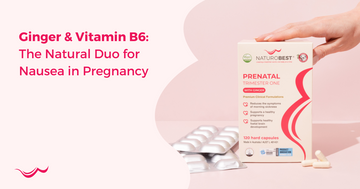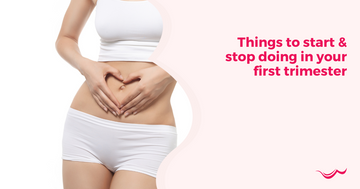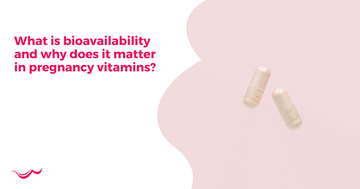How to Know if Your Pregnancy is Viable
by NaturoBest Naturopath Team on May 02, 2022

Positive pregnancy test results are one of the most thrilling experiences a woman can go through. In addition to arming yourself with information about what vitamins to take and what foods to consume during pregnancy, you may also wonder if your pregnancy is viable.
What Is a Viable Pregnancy?
The word “viable” comes from the Latin word vita, meaning “life.” A viable pregnancy is one that is developing normally and has the potential to continue until birth. In simple terms, it means that your baby is growing as expected and your body is supporting the pregnancy.
During the first trimester, it can sometimes be difficult to know whether a pregnancy is viable. In early pregnancy, ultrasound scans are used to assess development, but occasionally it may take more than one scan to confirm the outcome.
Doctors use specific criteria to diagnose a nonviable pregnancy (a pregnancy that will not continue). These ultrasound findings may include:
- A crown-rump length greater than 6 mm with no heartbeat
- A gestational sac greater than 24 mm with no embryo
- No heartbeat two weeks after a scan showing a gestational sac without a yolk sac, or no heartbeat 10 days after a scan showing a gestational sac with a yolk sac
These guidelines help ensure accuracy and avoid diagnosing a nonviable pregnancy too early, as development can vary slightly in the first few weeks.
When Is The Viability In Pregnancy Determined
Once you find out you’re pregnant, one of the next exciting steps is to schedule your first ultrasound appointment.
At this scan, your doctor will check that your baby is developing as expected for how far along you are, and that the pregnancy is located safely in the uterus (not the fallopian tubes). The ultrasound also helps detect any early developmental concerns for you or your baby. This first scan is often called a dating scan because it helps confirm how far along you are and estimate your due date. It’s usually done around 6 to 8 weeks of pregnancy, and the earlier it’s performed, the more accurate it tends to be.
Seeing your baby’s heartbeat for the first time is a wonderful moment, it confirms that the pregnancy is viable and progressing as it should. The tiny heart usually starts beating about 22 to 25 days after conception, but it’s typically visible on ultrasound from around 6 weeks.
Before the heartbeat can be seen, another good sign that your pregnancy is developing normally is a healthy rise in human chorionic gonadotropin (hCG) levels. In early pregnancy, hCG levels usually double every 1.5 to 2 days. Around the time of a missed period (about 4 weeks pregnant), an average hCG level is around 100 IU/L.
Each pregnancy is unique, so if you’re unsure about your scan timing or results, your healthcare provider can guide you and help ensure everything is on track.
What is a Nonviable Pregnancy?
Hearing that your pregnancy is nonviable can be devastating. This means that, sadly, the baby is not developing as expected and would not be able to survive outside the womb. It’s completely normal to feel heartbroken and overwhelmed after such news — take the time you need to process and seek support if you need it.
A viable pregnancy is one where the baby has a chance of survival outside the womb with medical care. This is usually from around 24 weeks of pregnancy, when the survival rate is between 60 and 70 percent. Before this stage, particularly under 24 weeks, survival is much less likely, though outcomes can vary.
Your healthcare team will support you through every step, explaining what to expect and helping you make the best decisions for your health and wellbeing.
There are several causes of a nonviable pregnancy, and it could be the following conditions below:
An ectopic pregnancy occurs when a fertilised egg implants outside the uterus, most commonly in a fallopian tube. Because the pregnancy cannot progress normally, it can cause serious, even life-threatening bleeding if left untreated. In rare cases, an ectopic pregnancy can also occur in an ovary, the abdomen, or in the lower part of the uterus near the cervix.
Molar Pregnancy
A molar pregnancy, also known as a hydatidiform mole, is a rare condition affecting about 1 in 1,000 pregnancies. It happens when the cells that normally form the placenta grow abnormally.
- In a complete molar pregnancy, there is no baby — only abnormal placental tissue forms after an empty egg is fertilised.
- In a partial molar pregnancy, both placental and embryonic tissue develop, but with too many chromosomes. This prevents normal foetal growth, and a cluster of tissue, or “mole,” forms inside the uterus instead.
Blighted Ovum
A blighted ovum, also called an anembryonic pregnancy, occurs when a fertilised egg implants in the uterus but does not develop into an embryo. This is a common cause of early miscarriage and is often due to chromosomal or genetic abnormalities, or issues with egg or sperm quality.
A low hCG level can sometimes be an early sign that something isn’t right. For example, an hCG level below 20 IU/L may indicate a possible blighted ovum or an impending miscarriage. Your healthcare provider will use ultrasound and blood tests to monitor hCG levels and determine the next steps.
Preparing for a Successful Pregnancy
In the early weeks of pregnancy, before those reassuring little kicks can be felt, it’s natural to worry about whether everything is progressing safely. Take a deep breath, understanding what defines a viable pregnancy can help you feel more informed and in control.
If you’ve experienced a nonviable pregnancy before, remember that this doesn’t mean you can’t have a healthy baby in the future. Many women go on to have successful pregnancies. However, if you’ve had more than one miscarriage, it’s important to speak with your healthcare practitioner to explore possible underlying causes.
While it’s not always possible to prevent pregnancy complications, maintaining good reproductive health can make a difference. One of the most effective steps is to start taking preconception vitamins about three to four months before trying to conceive. These help prepare your body for conception and support a healthy pregnancy. Once pregnant, continuing with prenatal vitamins will provide the nutrients needed for a healthy pregnancy and baby.
Wherever you are in your journey, it’s never too early to begin preparing for pregnancy. Taking proactive steps now can help you nurture a strong foundation for a viable and healthy pregnancy.




